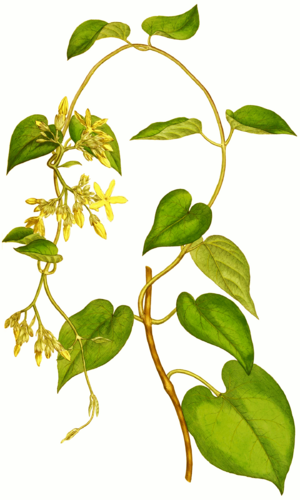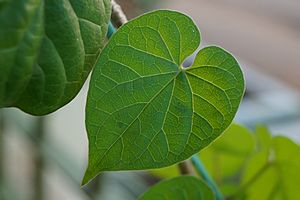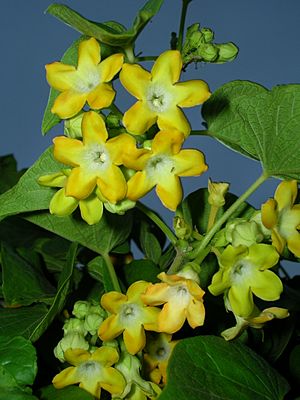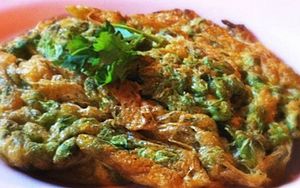Chinese violet facts for kids
Quick facts for kids Chinese violet |
|
|---|---|
 |
|
| Telosma cordata | |
| Scientific classification | |
| Genus: |
Telosma
|
| Species: |
cordata
|
| Synonyms | |
|
|
Telosma cordata is a beautiful flowering plant that comes from China and Indo-China. It belongs to the plant family called Apocynaceae. People grow this plant in many other places too, and sometimes it grows wild where it wasn't originally from.
This plant has many common names. Some of these are Chinese violet, cowslip creeper, Pakalana vine, Tonkin jasmine, and Tonkinese creeper. During the summer, it grows clusters of golden yellow flowers along its stems. These flowers open one after another over several weeks. They have a strong, sweet smell that fills the air day and night.
Contents
What Makes Telosma cordata Special?
Telosma cordata is a type of creeper plant. This means it can climb very high, sometimes reaching 2 to 5 meters (about 6 to 16 feet). Its vines are small, round, and very strong. When the plant is young, the vines are green. As the plant gets older, they turn brown.
This plant can grow a thick, white bush at its top. This bush can completely cover other trees. You can grow new Telosma cordata plants from cuttings or from seeds. It likes to grow in soil that gets plenty of air and in bright sunlight. You can find it in different types of forests across Indo-China. These include evergreen forests, mixed deciduous forests, and dry forests.
Leaves of the Plant
Telosma cordata has single leaves that are shaped like a heart. They grow in pairs on the vine. Each leaf is about 4 to 7.5 centimeters (1.5 to 3 inches) wide. They are also about 6 to 11 centimeters (2.3 to 4.3 inches) long. The underside of the leaf is smooth. The leaves are very thin, and you can clearly see the veins. The stem that holds the leaf is about 1.2 to 2 centimeters (0.5 to 0.8 inches) long.
Beautiful Flowers
The flowers of Telosma cordata grow in bunches. Each bunch can have about 10 to 20 flowers. The flowers are greenish-yellow and have a very strong, pleasant smell. This smell is especially noticeable in the evening. Each flower is about 1.5 centimeters (0.6 inches) across. They have 5 petals and 5 stamens (the parts that make pollen). These parts are all connected to each other and to the pistils (the parts that make seeds).
The main time for these flowers to bloom is usually from March to May. However, you might sometimes find flowers from July to October.
Fruits of Telosma cordata
The fruit of this plant is smooth, green, and round. It has pointed ends. Inside the fruit, there are many flat seeds. Each seed has soft, white fluff attached to its ends. The plant usually produces fruit around June to August.
How People Use Telosma cordata
Many parts of the Telosma cordata plant can be eaten as vegetables. This includes the young shoots, the fruits, and the flowers. Many people believe that the young shoots are the most nutritious part. The flowers are also used in desserts. Sometimes, people use the flowers to make beautiful bouquets and wreaths.
The vines of the plant are very tough. Because of this, they can be used like ropes. In some places, the wood from the plant is even used for building things.
For a long time, people have also used Telosma cordata in traditional medicine. It has been used to help with fevers and as an antidote for certain poisons. It can also help people relax and ease back pain.
Nutritional Value (per 100 grams)
This table shows some of the good things found in 100 grams of Telosma cordata:
| Nutrients | Amount per 100 grams |
|---|---|
| Carbohydrate | 10.6 g. |
| Protein | 5.0 g. |
| Fat | 1.1 g. |
| Fibre | 0.8 g. |
| Water | 80.5 g. |
| Vitamin A | 3.0 g. |
| Vitamin B1 | 0.0004 g. |
| Vitamin B2 | 0.0015 g. |
| Vitamin B3 | 0.0017 g. |
| Vitamin C | 0.68 g. |
| Calcium | 0.7 g. |
| Iron | 0.01 g. |
| Phosphorus | 0.9 g. |
See also
 In Spanish: Telosma cordata para niños
In Spanish: Telosma cordata para niños




